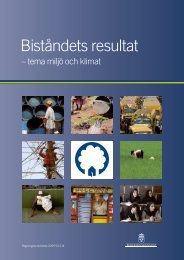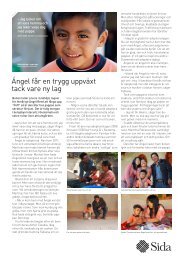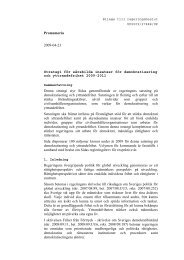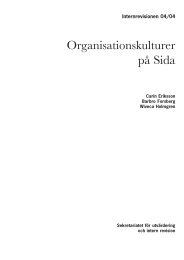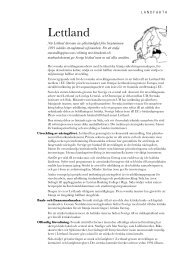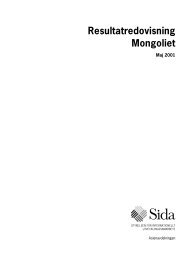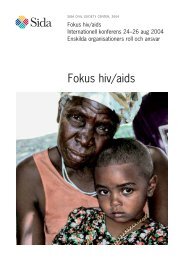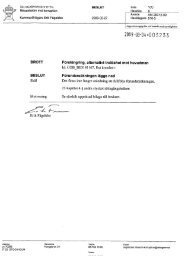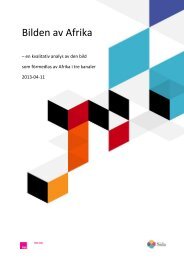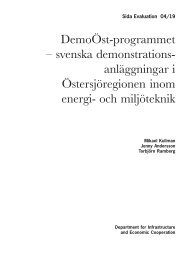Mid-Term Review of the AGIR Programme - Sida
Mid-Term Review of the AGIR Programme - Sida
Mid-Term Review of the AGIR Programme - Sida
Create successful ePaper yourself
Turn your PDF publications into a flip-book with our unique Google optimized e-Paper software.
2 F I N D I N G S<br />
and Forum Mulher). A positive aspect is that, backed by <strong>AGIR</strong> core funding, CSO<br />
partners are increasingly pushing for donors to finance <strong>the</strong>ir strategic plan, although<br />
with limited success, among o<strong>the</strong>rs due to <strong>the</strong> reduced availability <strong>of</strong> funding and<br />
weak fundraising skills/strategies <strong>of</strong> <strong>the</strong> partners.<br />
The main effort <strong>of</strong> <strong>the</strong> intermediaries has until now been concentrated on <strong>the</strong> capacity<br />
development <strong>of</strong> partners in organisational streng<strong>the</strong>ning with a focus on <strong>the</strong> development<br />
<strong>of</strong> strategic plans, <strong>the</strong> revitalisation <strong>of</strong> <strong>the</strong>ir governance bodies, and <strong>the</strong> improvement<br />
<strong>of</strong> <strong>the</strong>ir internal administration, finance, management and planning systems.<br />
As a core base <strong>of</strong> <strong>AGIR</strong>, all partners had strategic plans by <strong>the</strong> end <strong>of</strong> 2011, and<br />
new emerging partners are in <strong>the</strong> process <strong>of</strong> elaborating <strong>the</strong>ir strategic plans. Internal<br />
financial, management and planning systems are improving as well. Financial reports<br />
have been consolidated; <strong>the</strong>re is segregation <strong>of</strong> administrative and financial functions;<br />
and auditing reports are increasingly clear <strong>of</strong> critical observations. Besides, <strong>the</strong>re has<br />
been improvement to fiscal commissions and participation by social bodies in <strong>the</strong> life<br />
<strong>of</strong> <strong>the</strong> organisations, especially for <strong>the</strong> core-funded partners, which are contributing to<br />
better accountability and are crucial for transparency and <strong>the</strong> sustainability <strong>of</strong> <strong>the</strong> organisations.<br />
All <strong>of</strong> this contributes to internal and external credibility and increases<br />
<strong>the</strong> potential to attract funding for <strong>the</strong> implementation <strong>of</strong> <strong>the</strong> strategic plans.<br />
Towards outcomes in <strong>the</strong>matic sub-programme areas<br />
Although <strong>the</strong> intermediaries have mostly concentrated on CSO partner’s organisational<br />
streng<strong>the</strong>ning, results have been achieved that mark progress towards outcomes<br />
in all sub-programmes. Generally, as noted above, results-based monitoring undertaken<br />
by CSOs is still quite weak and consequently results have been poorly documented.<br />
However improvements were noted in 2012 as a result <strong>of</strong> partner capacity development<br />
in this area and greater attention to this weakness by <strong>the</strong> intermediaries. Progress<br />
towards outcomes has been somewhat influenced by <strong>the</strong> suspension <strong>of</strong> three<br />
partners under each <strong>of</strong> <strong>the</strong> <strong>the</strong>matic sub-programmes administered by Diakonia, IBIS<br />
and Oxfam and to <strong>the</strong> late start <strong>of</strong> SCC. Oxfam estimates that <strong>the</strong> current partner portfolio<br />
covers about 70% <strong>of</strong> <strong>the</strong> indicators for <strong>the</strong> four <strong>the</strong>matic areas <strong>of</strong> <strong>the</strong> subprogramme<br />
due to difficulties in identifying partners for specific gaps in two <strong>of</strong> <strong>the</strong><br />
<strong>the</strong>matic areas relating to <strong>the</strong> monitoring <strong>of</strong> public services and gender equity promotion.<br />
The possible implications <strong>of</strong> this are dealt with below.<br />
In general, across <strong>the</strong> four <strong>the</strong>matic sub-programmes activities such as research, information,<br />
debates and similar activities supporting knowledge-related outcomes are<br />
<strong>the</strong> most advanced in terms <strong>of</strong> achievement through increasingly updated and improved<br />
websites, public debates and events, radio programmes, community awareness<br />
development initiatives and such promoted by <strong>AGIR</strong> partners. 26 Fur<strong>the</strong>rmore, a large<br />
26 For example, knowledge outcomes concerning ‘Guidelines on how to access public information for<br />
<strong>the</strong> rights holders to monitor <strong>the</strong> governance process improved’ (in <strong>the</strong> sub-programme Access to Information),<br />
or ‘Improved access to <strong>of</strong> citizens and CSOs to legislation on natural resources’ (in <strong>the</strong><br />
sub-programme Streng<strong>the</strong>ning social accountability in natural resource management and community<br />
54




